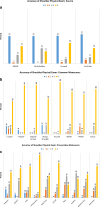The Quality of Open-Access Video-Based Orthopaedic Instructional Content for the Shoulder Physical Exam is Inconsistent
- PMID: 27703413
- PMCID: PMC5026661
- DOI: 10.1007/s11420-016-9508-6
The Quality of Open-Access Video-Based Orthopaedic Instructional Content for the Shoulder Physical Exam is Inconsistent
Abstract
Background: The internet has an increasing role in both patient and physician education. While several recent studies critically appraised the quality and accuracy of web-based written information available to patients, no studies have evaluated such parameters for open-access video content designed for provider use.
Questions/purposes: The primary goal of the study was to determine the accuracy of internet-based instructional videos featuring the shoulder physical examination.
Methods: An assessment of quality and accuracy of said video content was performed using the basic shoulder examination as a surrogate for the "best-case scenario" due to its widely accepted components that are stable over time. Three search terms ("shoulder," "examination," and "shoulder exam") were entered into the four online video resources most commonly accessed by orthopaedic surgery residents (VuMedi, G9MD, Orthobullets, and YouTube). Videos were captured and independently reviewed by three orthopaedic surgeons. Quality and accuracy were assessed in accordance with previously published standards.
Results: Of the 39 video tutorials reviewed, 61% were rated as fair or poor. Specific maneuvers such as the Hawkins test, O'Brien sign, and Neer impingement test were accurately demonstrated in 50, 36, and 27% of videos, respectively. Inter-rater reliability was excellent (mean kappa 0.80, range 0.79-0.81).
Conclusion: Our results suggest that information presented in open-access video tutorials featuring the physical examination of the shoulder is inconsistent. Trainee exposure to such potentially inaccurate information may have a significant impact on trainee education.
Keywords: internet-based education; physical examination; resident education; shoulder physical examination; trainee education; video-based education.
Conflict of interest statement
Ekaterina Urch, MD; Samuel A. Taylor, MD; Elizabeth Cody, MD; Peter D. Fabricant, MD, MPH; Jayme C. Burket, PhD; and Stephen J. O’Brien, MD, MBA have declared that they have nothing to disclose. David Dines, MD, reports personal fees from Biomet, outside the work. Joshua S. Dines, MD, reports personal fees from Conmed and Arthrex, outside the work. Human/Animal Rights This article does not contain any studies with human or animal subjects performed by the any of the authors. Informed Consent N/A Required Author Forms Disclosure forms provided by the authors are available with the online version of this article.
Figures

References
-
- Azer SA. Understanding pharmacokinetics: are YouTube videos a useful learning resource? Eur Rev Med Pharmacol Sci. 2014;18(13):1957–1967. - PubMed
LinkOut - more resources
Full Text Sources
Other Literature Sources
Medical

